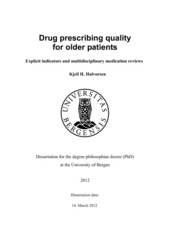| dc.contributor.author | Halvorsen, Kjell H. | en_US |
| dc.date.accessioned | 2012-06-04T09:17:25Z | |
| dc.date.available | 2012-06-04T09:17:25Z | |
| dc.date.issued | 2012-03-16 | eng |
| dc.identifier.isbn | 978-82-308-1989-0 | en_US |
| dc.identifier.uri | https://hdl.handle.net/1956/5820 | |
| dc.description.abstract | This thesis is based on three published papers that illuminate different aspects of prescribing quality and drug use in older patients who receive home nursing services or live in nursing homes. Persons older than 65 years account for about 15% of the Norwegian population, but use almost half of all prescribed drugs. Age-related and physiological changes affect drugs’ pharmacokinetics (absorption, distribution, metabolism and elimination). For example, a reduction of muscle mass and an increase in fat percentage will allow an accumulation of fat-soluble drugs, while reduce renal function will influence the pharmacological response and the elimination of drugs. Pharmacodynamic changes include up or down-regulation of receptors and altered receptor sensitivity. Along with reduced homeostasis, these factors puts older patients at risk of adverse drug events, possibly resulting in reduced quality of life, hospitalization and in worst case death. It is therefore important to identify and prevent inappropriate prescribing and drug-related problems. An explicit method for assessing prescribing quality is to compare patients' medication lists with a predefined list of drugs considered to be inappropriate for use in older patients. Such lists are eligible for screening of large populations, but they rarely take the patients' clinical conditions into consideration. Another method is to consider drug-related problems by conducting a systematic review of patients' overall drug use, taking their clinical conditions into consideration. Although systematic medication reviews are suitable for multidisciplinary collaboration between physicians, nurses and pharmacists, little knowledge exists about how this collaboration works and how it is perceived. The purpose of Paper I was to examine the quality of drug prescribing in older patients in nursing homes and home nursing services receiving multidose dispensed drugs, by means of explicit quality indicators. We studied 11 254 patients, of whom 2 986 were living in nursing homes, and 8 268 received home nursing services. On average, both patient groups were prescribed 5.7 regular multidose dispensed drugs. While relatively more patients in nursing homes used psychotropic drugs, those in home nursing service used cardiovascular drugs more frequently. Inappropriate drug use was found in 31% of patients in nursing homes and in 25% of home nursing service patients. Concomitant use of three or more psychotropic drugs and/or opioid drugs caused most problems. Potentially serious drug-drug interactions were found in ~ 10% of patients. The aim of Paper II was to test a multidisciplinary model to identify and resolve drug-related problems in nursing homes. Three pharmacists conducted systematic medication reviews in 142 patients. A total of 719 potential problems was presented to and discussed with the patients’ physician and primary nurse at case conferences, of which 504 drug-related problems were acknowledged by the multidisciplinary team. Most problems were associated with unnecessary drug use (n = 194) and the need for monitoring (n=68). Paracetamol, lactulose and zopiclone caused most drug-related problems. 94% of the problems were resolved within the next three weeks. The intervention resulted in an average reduction of 1.5 prescribed drugs per patient. In Paper III, we explored how physicians and nurses working in nursing homes and hospitals experienced multidisciplinary collaboration with pharmacists to optimize drug therapy in older patients. By interviewing physicians and nurses, we found that these two professions had different expectations in relation to pharmacist contributions. While physicians felt that the pharmacists questioned their drug therapy choices, nurses experienced that focus changed away from their tasks, and towards drug-related issues. Both professions expressed, however, that the presence of pharmacists resulted in a positive focus on prescribing quality and quality improvement. However, before implementing this service in NHs, there is a need to make an organisational frame for this collaboration to support the professional role of the pharmacist. This thesis shows that the quality of drug treatment in the studied patient groups is sub-optimal. Many older patients in nursing homes and those receiving home nursing services are exposed to potentially inappropriate medications. Multidisciplinary cooperation between physicians, nurses and pharmacists can be developed in order to identify inappropriate drug use, and to resolve drug-related problems. | en_US |
| dc.language.iso | eng | eng |
| dc.publisher | The University of Bergen | eng |
| dc.relation.haspart | Paper I: Halvorsen KH, Granas AG, Engeland A, Ruths S. Prescribing quality for older people in Norwegian nursing homes and home care services using multi-dose dispensed drugs. Pharmacoepidemiology and Drug Safety. 2011 (E-pub). Full text not available in BORA due to publisher restrictions. The article is available at: <a href="http://dx.doi.org/10.1111/j.1939-7445.2011.00095.x" target="blank"> http://dx.doi.org/10.1111/j.1939-7445.2011.00095.x</a> | en_US |
| dc.relation.haspart | Paper II: Halvorsen KH, Ruths S, Granas AG, Viktil KK. Multidisciplinary intervention to identify and resolve drug-related problems in Norwegian nursing homes. Scandinavian Journal of Primary Health Care. 28(2): 82-88, June 2010. Full text not available in BORA due to publisher restrictions. The article is available at: <a href="http://dx.doi.org/10.3109/02813431003765455" target="blank"> http://dx.doi.org/10.3109/02813431003765455</a> | en_US |
| dc.relation.haspart | Paper III: Halvorsen KH, Stensland P, Granas AG. Physicians and nurses experiences of multidisciplinary collaboration with pharmacists at case conferences - A qualitative study. International Journal of Pharmacy Practice. 2011; 19: 350-57. Full text not available in BORA due to publisher restrictions. The article is available at: <a href="http://dx.doi.org/10.1111/j.2042-7174.2011.00129.x" target="blank"> http://dx.doi.org/10.1111/j.2042-7174.2011.00129.x</a> | en_US |
| dc.title | Drug prescribing quality for older patients. Explicit indicators and multidisciplinary medication reviews | en_US |
| dc.type | Doctoral thesis | |
| dc.rights.holder | Copyright the author. All rights reserved | |
| dc.subject.nsi | VDP::Medical disciplines: 700::Health sciences: 800::Health service and health administration research: 806 | eng |
